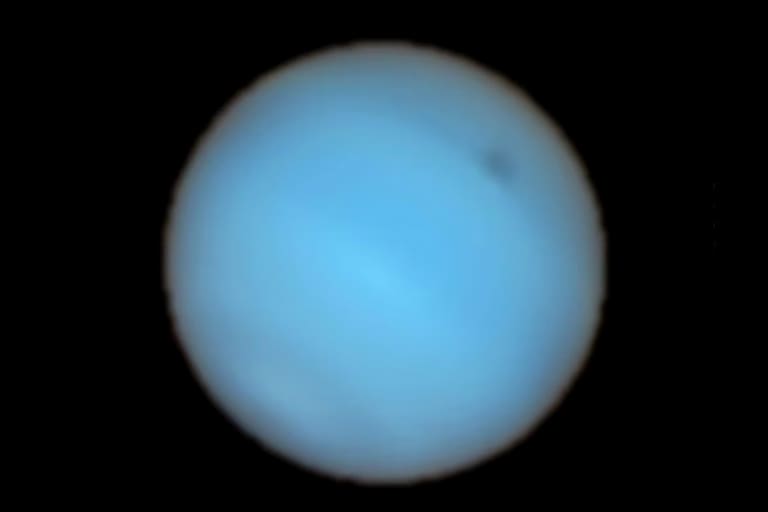Madrid.- More than 30 years ago I was able to observe Dark spots on Neptune. In the ice giant, these planetary-sized vortices appear and disappear, and they are similar to Earth in their extension, and their nature is Unknown beyond what can be observed in its atmosphere. To deepen this cosmic mystery, an international consortium published today in Scientific journal natural astronomy And analyze the phenomenon through the ground-based telescope, which is the first to be able to capture and analyze the Great Dark Spot.
thanks for the A very large telescope (VLT), group led Patrick IrwinA professor at the University of Oxford, UK, has identified an aerosol (any solid or liquid particle that interferes with sunlight) as the reason for the darkening of the nebula formation compared to the common blue background of the planet Neptune. atmospheres. Irwin’s team wrote in the study that they were able to analyze the sunlight reflected from the planet at different wavelengths, in order to determine the height at which the spot is located or the nature of its obscuration relative to the rest of the planet. the weather. And all this with the help of MUSE’s tool European Southern ObservatoryHe lies on a desert hill Atacama in Chile, where the VLT is located.
A study of Neptune’s outer atmosphere indicates the presence of Clouds, icy clouds of methane, and, at greater depths, of hydrogen sulfide. Underneath the hydrogen sulfide clouds, the models indicate that there is also Clouds of ammonium hydrosulfide or water, but in the absence of observations at such depths the presence of the latter has not yet been confirmed.explains the co-author Daniel Toledo. For the physical National Institute of Aerospace Technology (INTA)The most important part of his work is understanding that the Neptune dark spot is caused by a change in the nature of aerosols deep within the planet, not by a gap between clouds windy in those heights.
probe Voyager 2 in 1989 and telescope Hubble in 1996 They have obtained snapshots of various large spot sites on Neptune during their spaceflights. Photographs, Toledo explains, are useful for determining the size and shape of phenomena, “and are essentially an external description of vortices.” But to find out its composition, the scientists needed the VLT’s MUSE instrument, which is capable of performing analysis of “the full spectrum of the vortex, at many wavelengths.” Thanks to spectral technologies. The surprising thing about the spot is that “from a certain wavelength, at 700 nanometers, it disappears,” as the physicist explains in detail when describing the 3D model of his research findings.
“Thanks to the difference in methane absorption with wavelength, we can determine the depths at which we observe light reflected from the atmosphere,” explains the INTA scientist. This indicates that the phenomenon seen occurs in the upper parts of the frozen planet’s atmosphere, at pressure levels of 4-5 bar, which is lower than the level of methane cloud precipitation seen in classical images. from neptune Toledo draws a terrestrial analogy: “On Earth the same thing happens with ultraviolet light, which is mostly absorbed by ozone in the stratosphere. Thus, if we look at Earth from outside its atmosphere, the light reflected in ultraviolet radiation is due to interactions between sunlight and the atmosphere at altitudes above the ozone layer.
Although he is aware of the limitations of the study focusing on the planet’s outer layer, Toledo celebrates it “Knowing that the dark spot is the result of an atmospheric phenomenon that occurs at depths where our knowledge is very limited due to the lack of direct observationsThe work itself shows that it is still not known what caused the motion within the Great Spot, although scientists hypothesize that it “could be related to the photolysis of some gases” in the giant.
Researchers Irwin and Toledo highlight their ability to obtain an image from Earth that contains a lot of information about the seventh planet in the solar system. But the co-author stresses that future research will require space probes to be able to push the limits of current models: “The next step would logically be a mission dedicated to these planets. [Urano o Neptuno]Since the ice giants are the only planets in the solar system that have not had a mission assigned to them. And Toledo stresses that sending probes will be a “high priority” for NASA in the coming years, given the knowledge that these natural satellites can provide about the origin of the solar system or help them in space exploration, given their similarity to exoplanets. that they study in the Milky Way.
Posted by John Goretz Aranz
© El Pais, SL


:quality(85)/cloudfront-us-east-1.images.arcpublishing.com/infobae/M2WM2XUC45HSLIFGISE2ZUIZXU.jpeg)


